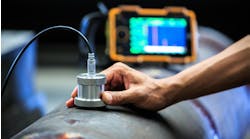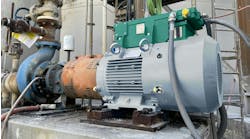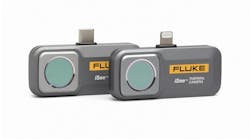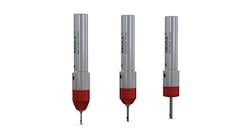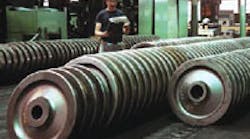Typical steel wheels produced at Standard Steel.
Tapping one of the electric arc furnaces at Standard Steel.
Wheel rolling in the vertical wheel rolling mill at Standard Steel. Note that there is no mandrel.
Wheel and axle assemblies, ready for shipment.
Very few companies in North America trace their roots back 210 years, but Standard Steel of Burnham, PA, will reach that milestone next year. Established in 1795 as Freedom Forge, the company is likely the oldest continuously operating forging company in America.
It also continues a tradition, established soon after the company was founded, of producing its own forging materials, by casting steel ingots in its own electric arc melt shop.
Over the more than two centuries, it has survived some tough times. The worst came in 2001, when the company, operating as Freedom Forge Corp., filed for Chapter 11 bankruptcy protection. This occurred in spite of the fact that the company had just invested over $30 million to upgrade its wheel manufacturing facilities.
Company officials cited a general decline in the railway industry, which resulted in a significant drop in demand and reduction in prices of core products, as the main reason for seeking reorganization under Chapter 11. Other factors included high structural costs, rising energy prices, and significant legacy costs related to the employee retirement plan.
In 2002, Farrell and Co. and CCIL, an affiliate of Citicorp Venture Capital, purchased the company out of bankruptcy and renamed it Standard Steel, LLC. Michael Farrell had served as CEO of Freedom Forge Corp. since the company filed for bankruptcy July 13, 2001, and after the purchase, he became president and CEO of Standard Steel, LLC.
USWA Local 1940, the union representing workers at Standard Steel, ratified a five-year contract with Farrell and Co., following the purchase.
In a message to Standard Steel employees, dated July 31, 2002, Mike Farrell wrote: "It has been a long and challenging process to bring Standard Steel out of bankruptcy and back to a position where we can compete strongly and well. Together, we have accomplished what some of our competitors thought could not be done."
He continued, "On behalf of the leadership team of Standard Steel, welcome to our future ... a future we will build together."
Subsequent to its establishment as a limited liability company, Standard Steel exited the commercial ring rolling and steel ingot businesses, and ceased operations at its Latrobe, PA, plant, choosing to focus production at its Burnham plant on its most significant market, the railway industry. Today, Standard Steel is a recognized leader in supplying railway wheels and axles to the freight, diesel, and rapid transit markets.
Serving the railway industry
Standard Steel has been involved with the railway industry since the early days of railroading. In 1904 the company produced the first solid forged and rolled wheel in the United States. In 1911 it developed a rolled steel center for bolted-type tires. In 1926, it introduced a slow cooling process to reduce susceptibility to internal stress fractures. Four years later the company introduced the Freedom Wheel, the industry's first heat-treated railroad wheel.
Today, Standard Steel provides the state-of-the-art S-Plate Wheel, incorporating a curved plate designed to minimize overheating. Designs for its wheel products are developed with the aid of computer-based finite element analysis.
Operations overhaul
Freedom Forge modernized its wheel shop in 1982 when the S-Plate Wheel was introduced, but shortly after celebrating its 200th anniversary in 1995, the company decided that the shop needed another overhaul. The overhaul began with replacing a 1917 vintage wheel mill, which was no longer efficient despite upgrades over more than 80 years. Many other improvements were installed, ranging from sawing of ingots through forging and rolling to quality control.
Today, the wheel production process begins when cylindrical bottom-poured steel ingots are sent from the melt shop to the wheel forging shop for sawing on one of ten Behringer band saws. They cut the 20-ft long ingots into wheel blocks of precise weights. A scale at each saw table assures that a block is cut to the proper weight for the wheel design being produced. Before installation of the saws, ingots were torch cut into blocks. Sawing the blocks improved yield and consistency.
After cutting and weighing, blocks are charged into a gas-fired rotary hearth furnace for heating to the required forging temperature. The furnace has five sequential heating zones, starting at 1600°F and graduating to 2300°F in the final zone before forging. The furnace is computer controlled and uses regenerative burners for improved efficiency.
The blocks are removed from the rotary heating furnace at 2,300°F and are placed on the platform of a descaler unit. An elevator lowers the block into the descaler where the block is blasted with high-pressure water to remove the iron oxide scale before forging. The descaled block is moved by a robotic manipulator to the table of the 10,000-ton forging press.
10,000-ton forging press
Computer control of the two-stage forging operation begins when the manipulator releases the block onto a table in the 10,000-ton forging press for pre-forming. In the first operation, only the top of the block is shaped.
After the first operation is completed, the bottom table slides to locate the second operation die in position for the second forge "hit." The second operation shapes of the preform bottom.
The 10,000-ton forging press was completely refurbished as part of the wheel mill modernization project. Hydraulics and structural components were rebuilt and press control systems were updated.
After the pre-form is completed on the 10,000 ton forging press, a robotic manipulator removes the piece from the press and passes it to a second manipulator for insertion into the Wagner vertical wheel rolling mill.
Vertical wheel rolling mill
The state-of-the-art, computer-controlled wheel rolling mill is capable of producing the world's most precise forged railroad wheel. Web rolls, which perform the driving function to rotate the wheel during rolling, contact the pre-form in the plate area. The mill back roll and other tooling such as web rolls, upper and lower centering rolls, conical edging rolls, and guide rolls provide the forces necessary for shaping the pre-form into a wheel. Wheel rolling is accomplished without a mandrel through the center of the wheel
The diameter of the pre-form is expanded significantly as it is rolled into a wheel. During the rolling process, the diameter is monitored using a laser measuring system focused on the tread area of the piece. In addition to the laser, there are thirteen position control indicators and twenty-six pressure transducers involved in controlling the mill tooling to obtain correct rolled dimensions in the finished product. When the wheel reaches the values specified for the wheel design being produced, rolling automatically stops. The mill edging rolls, side rolls, and centering rolls assure that a uniform, concentric wheel with the required flange is produced. Rolling time is less than one minute per wheel.
After rolling, the wheel is inserted into the 4,000-ton dishing and punching press by a robotic manipulator.
Dishing and punching is accomplished in a two-stage operation that forges the final wheel shape. The first operation, known as dishing, shapes the wheel into the modern S-plate design. This design results in much lower thermal stresses in railroad service than the older, straight-plate wheel design. The second operation is punching, which produces a center hole for mounting the wheel on the axle.
Hydraulic and mechanical systems on this press were also upgraded in the modernization program.
Following the dishing and punching operations the wheel is transferred by robotic manipulator to a station where the manufacturing identification information is automatically stamped on the wheel hub. Next is precise heat treatment and machining to customer and AAR specifications.
Inspection
The final step in the production process is the world's first phased-array ultrasonic inspection system for railroad wheel rims, developed and installed by Krautkramer-Branson Inc. This inspection satisfies the requirements of the American Association of Railroads for ultrasonic inspection. In phased-array technology, multiple transducers are mounted in a single housing and the transducers are electronically fired in sequence to effect the ultrasonic inspection. The dimensional data for each wheel rim design is programmed into the system computer so that scanning is accomplished on the desired rim section.
Phased-array ultrasonic inspection system is installed on two wheel inspection lines at the Burnham plant, and is used to inspect all wheel rims made by Standard Steel.
The benefits of the computer-controlled system include faster inspection and improved inspection sensitivity. It allows for rapid changing of test configurations for different wheel designs, performance of multiple scans during an inspection, and performance of custom and special inspection scans.
With the phased-array system, operator test set-up time is minimized and inspection consistency has been improved. Operators no longer have to reposition ultrasonic inspection transducers for each different wheel design.
Finally, the computer-based system has several different security levels to facilitate updating of information. For example, only personnel specifically authorized to make changes to wheel design data sets are set up with passwords to do so.
New-generation enterprise system
Along with the operations overhaul, the company decided in 1999 it was time to replace the company's aging mainframe systems with a newgeneration system that would provide integrated support for the entire enterprise, from production scheduling and quality management, to sales, customer service, and finance.
The existing systems were not well integrated and data could not be updated in real time. The result was "multiple versions of the truth" across different departments, with a negative affect on productivity and customer service. In addition, the systems did not adequately report the costs related to various products, so there was little information for analysis or process improvement. Finally, the systems were expensive to operate and maintain.
Standard Steel executives believed that a well-designed software package would provide better information while virtually eliminating the cost of in-house software maintenance, and that an open systems approach would lower infrastructure costs.
With the help of a consulting firm, Standard Steel reviewed and documented key business processes, identified opportunities for streamlining, and outlined the requirements for a new information system. After looking at nearly a dozen different packages, the Standard Steel team selected the Axiom Enterprise Resource Management System from Axis Computer Systems, Inc., Marlborough, MA , for the following reasons:
- It integrates sales, production, quality, and financial management around a common base of information to provide real-time visibility of orders and operations, as well as costs and financial status
- It provides the full range of production management capabilities that support the manufacturing process, from melt to finished products.
- Axiom was developed to meet the special needs of steel producers and processors. For instance, it was designed to allow for the variations in quality that are fundamental to metals processing, and to trace material back to the original heat.
Within one year after deciding to install the Axiom package, it was completely implemented, replacing the previous systems.
"We realized productivity and customer-service improvements right away," recalls Dan Baker, director of information services.
"One of the big things was that we significantly reduced the effort needed to capture and recall product genealogy. Axiom allowed us to track product by individual tag number through the entire process. It also made it much easier to record metallurgical and dimensional inspection results, and to produce product certifications.
"Also," he notes, "Axiom gives us far better information on work-order status. We're able to answer most customer inquiries almost instantly now."
Adds Dan Patterson, senior vice president of finance and administration, "Since implementing Axiom we have a detailed model of how we produce our products. As material costs and processes change, we can quickly update our standards and better project future costs. And since Axiom's financial applications are tightly integrated with the operational modules, we can close each period within a few days and quickly see where we are in terms of actual performance."
The breadth and reliability of information maintained in the new system became particularly valuable when Standard Steel began a restructuring effort after filing for bankruptcy in 2001. Besides providing the financial visibility and controls to manage cash flow during a crucial time, the system provided Standard Steel managers with the information to analyze the profitability of the company's various products — and make decisions about which ones to focus on as the foundation for growth.
"Axiom has been one of the assets that helped us weather a critical period, and is now enabling us to execute our operating strategy better," says Patterson. "If we had to run the business today with our previous systems, it would be much more difficult."
Three notable results were produced by the implementation of the Axiom system:
- Based largely on the move to the new system and the streamlining it helped to achieve, today's information technology total cost of ownership is 30% less than it was in 1998.
- Customer service and productivity improved within the first year due to better order-status visibility, better scheduling, and automated reporting of tasks, such as genealogy tracking.
- Improved cost information from the system used to help facilitate successful restructuring in 2002/2003.
Summing up, Dan Patterson says, "The most valuable aspect of Axiom to me, as CFO, is that it gives us accurate, up-to-date visibility of both our costs and our financial performance."
Bright outlook
In July 2002, Mike Farrell wrote: "The acquisition of Freedom Forge creates some tremendous opportunities for us, moving forward. Our shared goal now is to rebuild the company we have created. By working together — a capability and attribute that we have proven without question to the industry and the marketplace — Standard Steel can become profitable on a sustained basis, thereby creating an environment where our employees will have job security, our vendors will have a valuable partner, and our customers will receive a well made and timely-delivered product."
The timing was right for the rejuvenation of Standard Steel. Equipment and systems put in place before bankruptcy are exceeding expectations.
That's good, because the railway market has rebounded, and the improved productivity helps Standard Steel meet the increased demand for wheels and axles. In fact, company officials are studying further new investments in machining and heat treating.
| TIMELINE FOR STANDARD STEEL AND FREEDOM FORGE 1795-Freedom Forge founded to produce iron bars and rods. 1811-Freedom Iron Works founded, annual capacity 145 tons. 1812-Blast furnace installed. 1834-1835-Completed construction of the Greenwood Furnace; annual capacity increased to 800 tons. 1856-Renamed Freedom Iron Co., annual capacity 1,310 tons, and the first ring mill in the U.S. installed. 1865-Company name changed to Freedom Iron and Steel. 1867-The Emma blast furnace is built. 1868-Two five-ton Bessemer converters, a rail mill, and a ten-ton steam hammer were added. 1875-Company name changed to Standard Steel; Charles T. Perry appointed as president. 1895-Standard Steel designs and introduces the first bolted and steel-tired railroad wheel. 1898-Forge shop built to produce railroad axles. 1903-Spring shop built to produce locomotive springs. 1904-The Standard Wheel is developed, a forged-and-rolled railroad wheel which became the new standard of the American railroad industry. 1917-Two 75-ton open-hearth furnaces and a new wheel mill added. WWI-Commercial operations modified to include artillery shells and howitzer forgings. 1930—Standard Steel developed the Freedom Wheel, the railroad industry's first heat-treated wheel. WWII-Commercial operations changed to include the production of gun barrels, tank castings and military forgings. Annual steel making capacity: 160,000 tons. 1958-1971-Four EAFs replace open hearth steelmaking, and two VAR furnaces and an AOD vessel are installed. 1968-World's largest automated axle-forging-machine and matching equipment added. 1975-1979—Ingot production converted to bottom-poured cylindrical-ingot design (an American exclusive). 1976-Purchase of Latrobe Forge & Spring Co., an electricfurnace steel producing and forging plant. 1977-Installed the largest modern ring-rolling mill in the United States. 1981-Incorporated as Freedom Forge. 1989-Senior management team purchases Standard Steel. 1995-Celebrates 200 years with the theme "Setting the Standard - Forging the Future." 1996-1998-Modernization of wheel manufacturing, the largest investment in company history. 2001-Freedom Forge files for bankruptcy protection. 2002-Standard Steel, LLC emerges from Chapter 11 after being acquired by Farrell and Company. 2003-Company closes Latrobe plant, exits commercial production of ingots and rolled rings, and focuses on production of railway products. |
| In preparation for this report, the author consulted "Recent Improvements in Wrought Railroad Wheel Production at Standard Steel," a research paper by Cameron P. Lonsdale and Robert D. Swartzell. For more information, visit the company's website at www.standardsteel.com/. |
